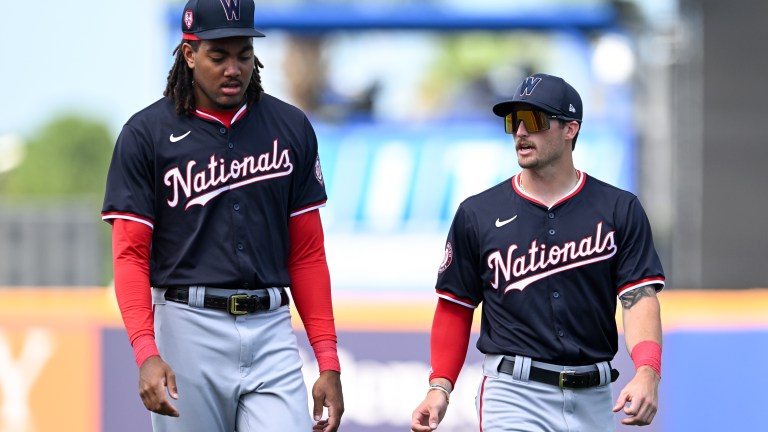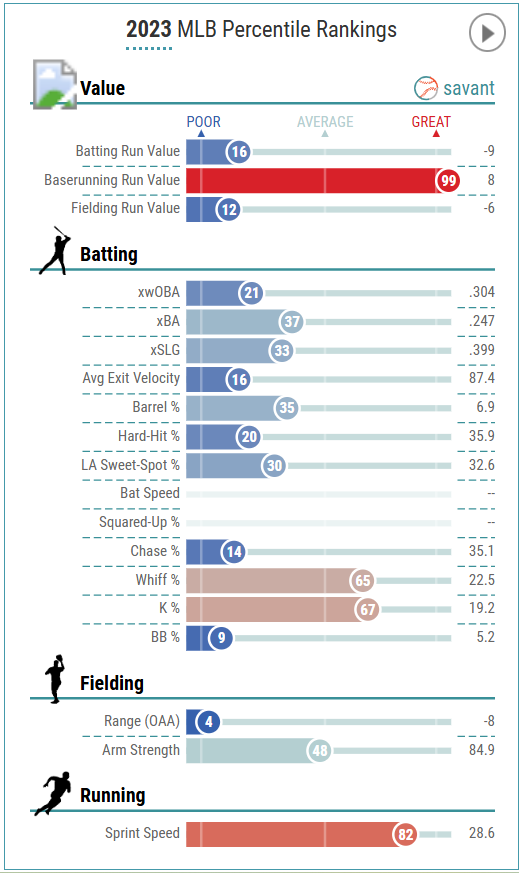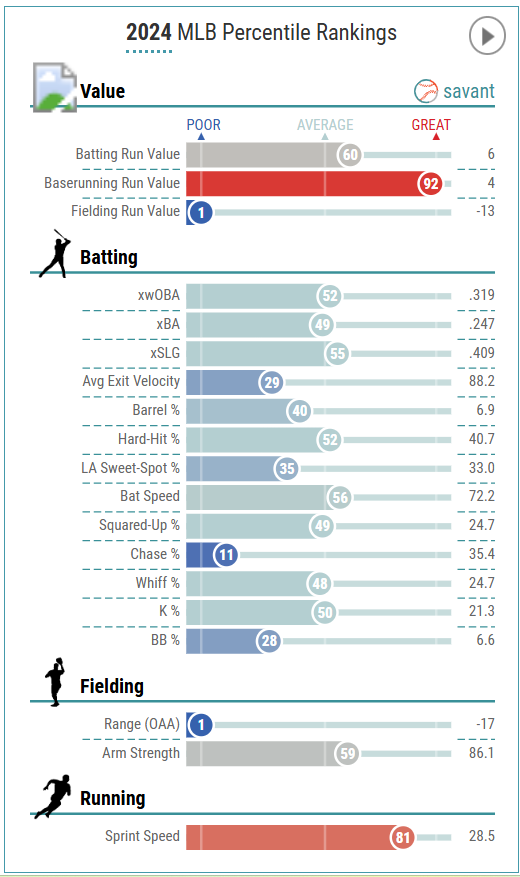Top Three Questions Facing the Washington Nationals in 2025
Though the Washington Nationals look as competitive as they've been since 2019, there are still some big questions looming over them in 2025.

While the Washington Nationals may’ve finished 20 games below .500 for the second consecutive season, there’s a growing sense of optimism in the nation’s capital for what could be in store for them in the future.
Looking back a year ago, by the time June came around in the 2023 campaign, the Nats sat second last in the National League, only a half-game up on the Colorado Rockies. Fast forward to June 1 this past year and Washington was well within the wild-card mix after the first two full months of the season, sitting just two games back from the final NL Wild Card position.
And even after things started to unravel in the second half for the Nationals, it wasn’t doom and gloom like it had commonly been in years past, thanks in large part to the call-ups of two premier prospects in James Wood and Dylan Crews, along with some inspiring play in the rotation.
Now with so much young promise across the board to start the 2025 season, the Nationals look to flip the script and move back into the picture of contention for the first time since their magical World Series title run in 2019.
But even with so much optimism to be had, there are still some key questions that loom over the Nationals and their quest for success.
Here are the top three questions facing Washington in 2025.
Can Future Franchise Cornerstones Shore Up Weaknesses at the Big League Level?
The Nationals have some serious young star power in the lineup at the major league level, as their window of postseason contention looks like it’s starting to arrive.
But with such potential also comes growing pains, as these future cornerstones continue to get acclimated to baseball in the big leagues.
Each of the three main pieces of the Nationals future offensively has certain weaknesses that stand to be corrected to some degree.
Because at the end of the day, a team is only as good as it’s franchise centerpieces, so will these three difference makers make the necessary strides to go from good ball players to great ones?
James Wood
Before graduating from prospect status in 2024, Wood was Just Baseball’s top prospect for a reason.
In 336 plate appearances, the 22-year-old outfielder showcased a myriad of those skills at the MLB level. He demonstrated his power hitting abilities with a 92.8 mph AVG exit velocity and 52.0% hard-hit rate. He displayed his strong ability to draw walks, posting a BB% of 11.6%. And he flashed his immense speed, sporting an 85th percentile sprint speed, according to Baseball Savant.
But even with how well he performed as a rookie, there’s one glaring aspect of his game that could due with some work: his strikeout rate. Wood struck out at 28.9% clip last season, and if he were a qualified hitter that would give him the sixth highest K-rate in all of baseball.
A reason for this is that he found himself whiffing at poor rate, sporting a 29.6% whiff rate in 2024.
There’s a few reasons that I believe he can improve upon his inability to avoid striking out.
For one, he doesn’t chase pitches, in fact he’s one of the best in the league for not chasing pitches as he posted just a 21.0% clip in 2024.
Secondly, we’ve seen him drop his K-rate in the upper minors recently before his call-up. He cut his strikeout rate down from 15.5% from 2023 in Double-A (33.7%) to Triple-A in 2024 (18.2%).
He’s remained a hitter that walks and doesn’t come undone at the plate, so if he can activate some of that Triple-A magic with a lower that K-rate, Wood will become that much more feared as a hitter due to his roundedness.
Dylan Crews
With Crews it’s hard to pinpoint an exact weakness of things he needs to improve upon as a major leaguer. He’s a plus defender, possesses excellent speed, has an above average approach at the plate, and there’s a lot to dream on with the hit tool and the power tool.
But “dream on” is the key phrase when it comes to the aforementioned hit and power tool, as his first 31 games and 132 plate appearances at the major league level exposed some areas of improvement when it comes to quality of contact.
Crews found himself producing either weak contact or topping the ball 44.7% of the time, while only making solid contact or barreling pitches 14.9% of the time during his late season big league cameo in 2024.
This resulted in just a .218 AVG and .353 SLG, along with mediocre expected metrics of a .253 xBA and a .418 xSLG.
Should he be able to convert some of that weaker contact to more solid contact, or even get under the ball more, or find a way to make flare or burner contact, then he has a better chance to reach his 55-grade hit tool FV and 60-grade game power tool FV.
Another way Crews could improve his major league hitting metrics is to find a way to improve on hitting breaking pitches.
Of the three breaking pitches that he saw 40 or more pitches against last season after getting called up, he hit no higher than .231 against any of them, while also slugging no higher than .231 and posted wOBA totals below .210 for each pitch.
| Pitch Type | Pitches Faced | AVG | SLG | wOBA |
| Slider | 80 | .000 | .000 | .128 |
| Sweeper | 63 | .231 | .231 | .208 |
| Curveball | 49 | .091 | .091 | .082 |
If he can just become passable against the breaking stuff, it offers him a chance to not just become a more well-rounded hitter, but will allow him more of a chance to see pitches he’s more comfortable with, like four-seam fastballs, which he hit .333 against with a .697 SLG in 2024.
CJ Abrams
The 2024 season may not have ended the way Abrams probably anticipated, after his second half struggles lead to Washington demoting him to Triple-A due some off-field professionalism issues.
Putting all of that aside and looking at the 2024 season as whole, his underlying metrics didn’t look great, but he actually increased most of them from his 2023 totals, other than his swing-and-miss metrics (K-rate, chase rate and whiff rate), a three percentile drop in defensive range, and a slight single percentile drop in sprint speed.

CJ Abrams 2023 Underlying Metrics, as per Baseball Savant

CJ Abrams 2024 Underlying Metrics, as per Baseball Savant
From a surface level standpoint, Abrams has seen steady AVG totals alongside gradual improvements year-in and year-out in areas like HR, OBP, SLG, and wRC+.
| Season | PA | HR | AVG | OBP | SLG | wRC+ |
| 2022 | 302 | 2 | .246 | .280 | .324 | 72 |
| 2023 | 614 | 18 | .245 | .300 | .412 | 91 |
| 2024 | 602 | 20 | .246 | .314 | .433 | 107 |
The big issue for Abrams is consistency throughout 162 games. While every player goes through droughts, the question for Abrams is can he be the same player in the second half of the year that he is in the first?
From Opening Day up until the end of June, Abrams was a 2.0 fWAR player in 332 plate appearances, slashing .283/.344/.513 with 13 HR, 42 RBI and a 135 wRC+, leading him to be selected to his first All-Star team.
But from July 1 onwards the script had completely flipped. The shortstop had stopped shining, as he was a -0.2 fWAR player in his final 270 plate appearances, slashing .199/.278/.332 with just seven HR, 23 RBI and a 72 wRC+.
His first half propelled him to become an above average major leaguer with a 107 wRC+ in 2024, so imagine what his numbers could’ve been of he didn’t rank among the bottom 10 in qualified hitters in wRC+ in the second half?
He’s shown there’s an All-Star hitter within him, so for the Nationals sake, they’ll need hope that their shortstop of the future finds a way to avoid falling into months long slumps like he did in July and August, or else they’ll be doomed to mediocrity at a position where premium output is crucial.
Can MacKenzie Gore Prove Himself to be a Frontline Starter?
For years the defining storyline of the Nationals rotation was the ineffectiveness of their $140 million man in Patrick Corbin.
But the Corbin era is over in D.C. and the focus now shifts to the young arms who made some noise in 2024, forecasting what could be an intriguing future for the franchise on the mound.
And that young core of pitching is lead by former top prospect MacKenzie Gore, fresh of a 2024 season where he made huge strides towards his top-end potential.
From 2023 to 2024 his ERA dropped from 4.42 to 3.90, his FIP dramatically dropped from 4.89 to 3.53, and he went from a 1.2 fWAR arm to a 3.2 fWAR arm.
And from a batted ball point of view, his hard-hit rate dropped from 43.7% to 38.1%, his HR/9 total dropped from 1.78 to 0.81 and his AVG exit velocity dropped nearly two mph from 89.9 to 88.0.
Gore’s fastball also saw improvements, with an uptick in velocity from 95.0 mph to 96.0 mph in that same time span.
He’s starting to look the part of a top-end starter, but the question remains can he lead the Nationals’ rotation into this window of contention. To do so he has to continue to improve upon the areas in which he made solid progress in in 2024, but also address some concerns in his game that still remain.
While he was able to lower both his ERA and FIP to sub-4.00 postings, his AVG against and WHIP were still poor, indicating that hitters are still seeing his stuff well. This past season Gore posted his third consecutive season with a WHIP at 1.40 or higher, and hitters actually found themselves hitting five points higher off of him than in 2023, marking the third straight year that his AVG against rose.
And looking at 2024 in vacuum, Gore’s 1.42 WHIP ranked him 56th out of 58 qualified starters, and his .261 AVG against had him in a three-way tie for 52nd out of 58.
| Year | ERA | FIP | WHIP | AVG Against |
| 2022 – SD | 4.50 | 4.11 | 1.47 | .246 |
| 2023 – WSH | 4.42 | 4.89 | 1.40 | .256 |
| 2024- WSH | 3.90 | 3.53 | 1.42 | .261 |
Gore also has to address his four-seam fastball. He uses the pitch at a 55.3% rate, however the .281 AVG and .418 SLG aren’t nearly the numbers you should expect from a successful number one starter’s primary pitch.
But the most glaring issue for Gore in 2024 was his lack of consistency from month to month. He had months where he looked excellent, like May and September, but then he would counter those months by looking extremely poor, like June and July.
| Month | IP | ERA | WHIP |
| April | 31.0 | 3.19 | 1.35 |
| May | 27.2 | 2.60 | 1.19 |
| June | 26.1 | 5.13 | 1.63 |
| July | 26.0 | 7.62 | 1.88 |
| August | 26.2 | 4.05 | 1.73 |
| September | 28.2 | 1.26 | 0.80 |
We saw spurts of just how dominant Gore can be last season, but the question remains, can he be that successful for more than just spurts? Because that’s what separates him from being a certified number one option, rather that the top-end hopeful he is at the moment.
The Nats have intriguing middle-to-bottom end of the rotation guys to back him up, like Jake Irvin, Mitchell Parker and DJ Herz, who all played big roles in the Nats 2024 rotation. They also have a top-end prospect in Cade Cavalli, who’s projected to make his return to the big leagues in 2025 after recovering from Tommy John surgery. And the recent signing of Michael Soroka for the rotation adds another interesting arm to the fold as well.
All that’s missing in Washington is a unanimous number one starter, and 2025 will be a crucial year in proving if Gore can be that guy, or whether he’s destined for a more middle-of-the-rotation type role in the future.
What Will This Bullpen Be by Opening Day?
The offense and the starting rotation have so much promise. And while both the Soroka deal and the recent acquisition of first baseman Nathaniel Lowe are welcomed additions, the bullpen is the place that requires the most attention this winter.
In 2024, the Nats ‘pen sat 21st in MLB in ERA, 22nd in WHIP, 27th in AVG against, and 26th in both strikeout and walk rate.
And they’ve now lost four key pieces in relief over the past five months. All-Star closer Kyle Finnegan and veteran Tanner Rainey getting non-tendered by the team this offseason. Robert Garcia, who made 72 relief appearances for the Nationals in 2024, was sent the other way to Texas in the Lowe deal. And Hunter Harvey was traded to Kansas City ahead of July’s trade deadline.
This means that Derek Law is the only pitcher remaining projected in the Nationals bullpen who threw 50+ innings in 2024.
While both of those names should play a role in the Nats ‘pen in 2025, with so many quality relievers still on the open market, there’s a real chance to invest in creating a solidified bullpen to match the type of output we could see from this offense and rotation in 2025.
While they shouldn’t sell themselves short on pitching the project to big-time free agent names like Tanner Scott or Jeff Hoffman, it doesn’t have to be a huge profile like that to have a significant impact at this point. Veteran closing arms like Kenley Jansen or Kirby Yates could be intriguing fits in later stages of their careers. Or even solid sixth-to-eighth inning arms like a Tommy Kahnle or a Phil Maton could be of intrigue here for Mike Rizzo and the front office.
The Nationals have taken an already lower-third ranked bullpen and subtracted from it, meaning that they absolutely need to replenish it in some manner. And with the right moves, this bullpen could be the final piece in making Washington a pesky team to watch out for in the NL in 2025.
